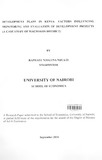Development plans in Kenya: factors influencing monitoring and evalution of developement projects (a case study of Machakos district)

View/
Date
2011Author
Nduati, Raphael N
Type
ThesisLanguage
en_USMetadata
Show full item recordAbstract
Most of the development plans prepared in Kenya including the Vision 2030 have provision for Monitoring and evaluation (M&E) as the means of feedback to the interventions outlined therein. This is normally found in the last chapter of the development plans, both at the national and devolved levels. Currently the government blue print, the Vision 2030 identifies Monitoring and Evaluation to provide the progress made on the vision development interventions and further establishes the National Integrated Monitoring and Evaluation System (NIMES) as the body to spearhead all M&E activities in the country.
The progress in implementation of Vision 2030 is done through the Annual Progress Reports which are based on the M&E framework in the country as provided by NIMES. However, over the years the establishment of monitoring and evaluation system has not been successful as expected despite several attempt to do so in the country. This means that the feedback mechanism on development intervention is affected. M&E is an area that has not been given much attention in terms of doing research and considering the major roles its currently playing in Kenya in reporting of progress from development plans, there was a great need for the study.
The major objective of this study was to establish the factors that influence M&E of development project by taking a case of Machakos district. It also looked at the level of influence of the factors and whether NIMES guidelines are significant factors that affect M&E in the country. In order to establish the extent this study employed the binary pro bit model on the cross-sectional data obtained from Machakos. Whether a project performed M&E was used as the dependant variable which was a limited dependent variable. The independent variable included; M&E skills measured in months of training, M&E budget, project duration, M&E plan, Stakeholders involvement, and source of funding.
The results found out that monitoring and evaluation budget, stakeholders' participation, M&E plan, source of funding (donor) and training in M&E had a positive relation with the probability of implementing M&E which was significant at 95% confidence level. However, NIMES guidelines were found to have no effect on implementation of M&E. further, the project duration and source of funding (community) had insignificant relation with probability ~ of implementing M&E in projects.
Based on the results the study concluded that Monitoring and Evaluation is important in providing the feedback mechanism of economic development interventions. As such the study recommended further studies in this area to ensure that the M&E is well established in the country and contribute to the efficiency in utilization of the scarce resources vis a viz development projects completion. Specifically there is a need to undertake a study on effectiveness of the National Integrated Monitoring and Evaluation (NIMES) in providing the
Reporting framework for Vision 2030.
Publisher
University of Nairobi, Kenya
